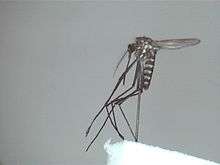Skusea pembaensis
Aedes pembaensis is a mosquito (Diptera: Culicidae).
| Aedes pembaensis | |
|---|---|
| Scientific classification | |
| Kingdom: | |
| Phylum: | |
| Class: | |
| Order: | |
| Family: | |
| Subfamily: | |
| Genus: | |
| Species: | Ae. pembaensis |
| Binomial name | |
| Aedes pembaensis Theobald | |
Distribution
Aedes pembaensis is the only representative of the Skusea subgenus on the African mainland, but several closely related species (Aedes lambrechti, cartroni, and moucheti) are present in Madagascar and some islands of the Indian Ocean.[1] Aedes pembaensis is found on the east coast of Africa, as far north as Pate Island, Kenya [2] and as far south as Maputo, Mozambique.[3]
The distribution of these mosquitoes seems to be strongly tied to the coast. Females have been found as far as four miles inland, but appear to be most numerous within one mile of the coast, whereas males are rarely found even one mile from the coast [4]
Biology
The larvae of Aedes pembaensis are primarily found in crab holes along the coast. The larvae are able to tolerate high degrees of salinity.[5] Larvae have been found in holes of Sesarma meinerti, Sesarma eulimene, and Cardisoma carnifex.[6] The eggs are laid on the crabs, which then transport the eggs into the holes which are burrowed into the water table.[7] Occasionally larvae are found in other habitats, such as tree holes or pineapple axils.[8]
The adult females feed on a variety of different hosts. Adults feed readily on humans.[4] Parasites of dogs, cats, and donkeys have also been found in female Aedes pembaensis.[9] Females were also shown to feed on lemurs [10] and an anaesthetized monkey.[2]
Females readily enter human habitations. In a survey on Pate Island in Kenya in 1956, 98 percent of mosquitoes collected in houses using a pyrethrum spray catch were Aedes pembaensis.[2]
Medical importance

Though originally thought to be a vector of Wuchereria bancrofti,[11] further testing has shown Aedes pembaensis to be a poor vector.[12] Lumbo virus has been found in the mosquitoes in Mozambique, but this virus does not appear to be pathogenic in humans.[13]
In recent entomological investigations of an outbreak of Rift Valley Fever virus in Kenya (2006-2007), Aedes pembaensis were collected and several were infected with the virus.[14] It is not known if Aedes pembaensis is capable of transmitting Rift Valley Fever virus.
References
- "Brunhes, J., 1977, Les moustiques de l’archipel des Comores. II. – Description de quatres espèces nouvelles ou peu connues. Répartition des members du sous-genre Skusea dans l’océan Indien occidental. Affinités de la faune culicidienne des Comores. Cahiers ORSTOM, ser Ent Med et Parsitol 15, 153-170."
- "Van Someren, E.C., Furlong, M., 1964, The biting habits of Aedes (Skusea) pembaensis Theo. and some other mosquitoes of Faza, Pate Island, East Africa. B Entomol Res 55, 97-124."
- "McIntosh BM. 1975. Mosquitoes as vectors of viruses in southern Africa. Entomology Memoir. No 43. Department of agricultural technical services. Republic of South Africa"
- "Brooke Worth, C., de Sousa, J., Weinbren, M.P., 1961, Studies on the life-history of Aedes (Skusea) pembaensis (Theobald) (Diptera, Culicidae). B Entomol Res 52, 257-261"
- "Hopkins, G.H.E., 1952, Mosquitoes of the Ethiopian Region. I.-Larval Bionomics of mosquitoes and taxonomy of culicine larvae, 2nd Edition. The British Museum, London, 355 p"
- "Bright DB, Hogue CL. 1972. A synopsis of the burrowing land crabs of the world and list of their arthropod symbionts and burrow associates. Contributions in Science. Natural History Museum, Los Angeles. No. 220, 60p"
- "Goiny, H., Van Someren, E.C., Heisch, R.B., 1957, The eggs of Aedes (skusea) pembaensis Theobold discovered on crabs. East Afr Med J 34, 1-2."
- "Teesdale C. 1941. Pineapple and banana plants as sources of Aedes mosquitoes. East African Medical Journal. 18:260-267."
- "Nelson, G.S., 1960, The identification of infective filarial larvae in their vectors. Indian Journal of Malariology 14, 585-592."
- "Fontenille, D., Mathiot, C.H., 1984, Resultats d’une année (1983) d’enquetes entomologiques sur les vecteurs d’arboviruses à Madagascar. Arch Inst Pasteur Madagascar 51, 161-202."
- "Heisch, R.B., Goiny, H.H., Ikata, M., 1956, A new vector of filariasis in East Africa. Trans R Soc Trop Med Hyg 50, 421-422."
- "Mosha, F.W., Magayuka, S.A., 1979, Potential vectors and non-vectors of Bancroftian filariasis in East Africa. East Afr Med J 56, 197-202."
- "Kokernot, R.H., Mc, I.B., Worth, C.B., De, M., Weinbren, M.P., 1962, Isolation of viruses from mosquitoes collected at Lumbo, Mozambique. I. Lumbo virus, a new virus isolated from Aedes (Skusea) pembaensis Theobald. Am J Trop Med Hyg 11, 678-682.
- "Sang, R., Kioko, E., Lutomiah, J., Warigia, M., Ochieng, C., O'Guinn, M., Lee, J.S., Koka, H., Godsey, M., Hoel, D., Hanafi, H., Miller, B., Schnabel, D., Breiman, R.E., Richardson, J., 2010, Rift Valley Fever Virus Epidemic in Kenya, 2006/2007: The Entomologic Investigations. American Journal of Tropical Medicine and Hygiene 83, 28-37."